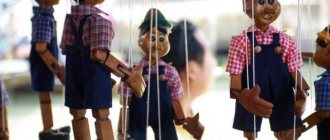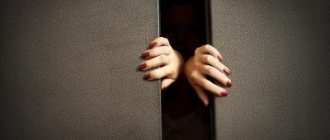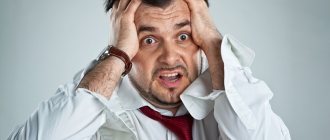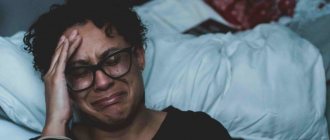Fear, a feeling of discomfort and the desire to run away from a person are nothing more than anthropophobia. Fear takes over when you have to speak on stage or answer in class at the blackboard or in front of an audience at the university. Before going out in public, fear causes your heart to beat loudly, your hands to sweat and tremble, and your legs to become weak. Many people feel a lump in their throat when they are forced to be in a group of other people. Fear of people is one of the forms of social phobia related to neuroses, in the International Directory of Classification of Diseases, listed under the code F 40 - phobic anxiety disorders. American psychiatrist G. Sullivan believed that in order to understand the reason that caused the phobia, it is important to “unravel the tangle” of relationships between a person suffering from fears and other people from his close circle.
Anthropophobia and social phobia: what are the differences?
Both of these anxiety disorders fall under the same general category: social phobia. Both of them are associated with fear of people, communication with them, or any social activity.
However, there are differences between a fear of people and social phobia. With social phobia, life is much easier for an individual than for an anthropophobe. Experiencing fear of people, the anthropophobe is forced to constantly avoid contact with representatives of any social groups or with all people in general. A sociophobe experiences discomfort when participating in any social activities, when communicating with a team or an unfamiliar company. In his case, eliminating the object of phobia from life is somewhat easier.
Symptoms
Many people feel uncomfortable when their personal space is violated. Every person has a comfort zone, penetration into which makes them nervous and worry about their safety. When a person wants to be alone, but is unable to be alone with himself, a deterioration in mood and even health may occur. These features are normal, but sometimes they can indicate developing anthropophobia.
The main symptom of anthropophobia is compulsive behavior. It consists of performing obsessive actions or movements. The purpose of this behavior is to protect oneself from phobias and block inappropriate manifestations of fear. An example of compulsion is incessant counting in a stressful situation. For example, a person, finding himself in a crowd, without stopping, counts passers-by.
This disease entails the occurrence of many unpleasant conditions. Various neuroses, mental disorders, and depression accompany the already difficult life of a patient with anthropophobia. He is afraid that a stranger will attack him or infect him with an incurable disease. The feeling of loss of health during social contacts is another of the main symptoms of anthropophobia.
His contacts are as limited as possible. He seeks to nullify communication even with the closest people. An anthropophobe will not ask for help and will most likely reject it if absolutely necessary.
Fear of people impairs a person's cognitive abilities. A subject who is overwhelmed by social anxiety has difficulty concentrating and is unable to absorb new information. He loses the ability to learn and develop. In parallel with problems with concentration, an anthropophobe has difficulties remembering and retrieving information.
It is not easy for someone suffering from such a phobia to find a job, because most professions involve communication. And any training requires communication, which is impossible, because the fear of people is stronger than the desire to work.
Causes and risk factors of anthropophobia
Although there are several assumptions about what anthropophobia is and what the mechanism of its development is, the exact causes are unknown. Most practicing psychologists are inclined to believe that its development is caused by events that take place in childhood or adolescence.
Anthropophobia is a deviation that occurs due to previously suffered:
- ridicule of peers,
- unfavorable family situation,
- resentment towards parents
- regular intimidation or punishment.
Detailed factors increase the likelihood that a child (whose personality is just beginning to form) loses trust in others. If you notice that he prefers privacy, this signal is worth paying attention to. A child, feeling calmer and more confident when alone, may come to the conclusion that the only safe person for him is himself. This is the starting point that leads to the emergence of anthropophobia.
Fear of people most often overtakes individuals:
- with a weak type of nervous system,
- prone to increased levels of anxiety,
- with neuroses,
- having low self-esteem and excessive self-criticism.
People with anthropophobia do not consider themselves part of society, sometimes as inferior or useless members of it. This is an exaggerated reaction of the psyche to a possible repetition of violence, ridicule and aggression from others, which came from parents, classmates or strangers.
Causes of social phobia
To recover from this mental disorder, you need to understand where society's fear comes from. And you need to start looking for the problem from childhood. The manifestation of pathology can be observed even in infancy, when the mother did not provide the child with proper attention and often left him with his grandmother or nanny. The fear of losing his mother took root in the baby’s psyche; he began to be afraid of other people, because he saw them as a threat. This made him more anxious, restless and whiny. And when such children grow up, they become alienated from people, become unsociable, and there is a high probability of misanthropy.
The emergence of social phobia can also be due to overprotection of a child. When parents care too much about their child, deciding everything for him and not giving him the opportunity to make mistakes, the child grows up completely dependent and unable to do anything without the help or advice of his parents.
As a result, a person becomes unsure of himself and his strengths and is afraid of condemnation of his actions by strangers.
Another cause of a phobia can be an incident or psychological trauma during adolescence or young adulthood. The teenager may have been rejected by peers, insulted or bullied at school. Often, fear is born after experiencing severe stress - parental divorce, betrayal of a loved one, violence, etc. Deprivation of virginity is a very sensitive issue, especially for girls at any age. If a girl was raped in her youth, then the manifestation of symptoms of social phobia will be almost one hundred percent.
Circumstances of deflowering can provoke social anxiety in a girl
Signs of anthropophobia
Anthropophobia is expressed by a specific clinical picture, which involves cognitive and autonomic disorders. Cognitive manifestations include an inexplicable, persistent fear of the thought of speaking, touching a person, going out to people, or meeting a dangerous person. Autonomic symptoms of fear make themselves felt:
- tremor of the limbs;
- attack of suffocation;
- rapid heartbeat;
- numbness;
- redness or pallor of the face, spots on the chest;
- sudden sweating;
- vomiting, diarrhea.
When panic attacks occur in anthropophobes, there is a need for compulsions - obsessive motor acts that have a protective meaning and are of the same type. Often compulsions are associated with cleaning (washing hands, cleaning, wiping surfaces, dishes). Fear of people, as a rule, has a high level of comorbidity, that is, it is combined with other disorders or diseases, such as depression, alcoholism, and drug addiction. Fear of communication is associated with autism.
Signs of the disease
Only when they are with themselves do such people feel comfortable
With social phobia, the symptoms must be recognized as early as possible, before the disease takes deep roots and changes the direction of a person’s life. Since the disorder may first appear in childhood and adolescence, timely recognition of symptoms is often a concern of the parents rather than the patient himself. As practice shows, social phobes themselves prefer to turn a blind eye to problems and get used to living in their own way, minimizing situations in which their illness may worsen.
Signs of social phobia manifest themselves on 4 levels at once - cognitive, behavioral, mental (emotional) and physical. As it progresses, the disease takes over level by level, and in severe forms it manifests itself with all the symptoms at once.
The first signs are behavioral disturbances. These include:
- severe stress experienced by the patient in society;
- desire for loneliness;
- confusion at moments when you need to somehow interact with a group of people;
- monosyllabic answers to questions posed;
- deliberate avoidance of situations in which social communication may be required from the patient.
In adolescence, this is manifested by refusal to attend school events and holidays, and attempts to avoid family gatherings where strangers may be present. Adult patients prefer to remain silent at corporate meetings, do not look strangers in the eye, and get confused when they need to say something to a group of people.
When a situation arises in which the phobia worsens, cognitive impairment appears. They are manifested by speech disorders - a person gets confused in words, may suddenly begin to stutter, and gets lost in a conversation. At the same time, confusion of thoughts and the inability to concentrate on the topic of conversation are noticeable. Also, social phobes tend to acutely experience any such failure associated with the fact that they were unable to find the right words, and as a result, they constantly play out in their heads possible scenarios for various conversations with colleagues, superiors, or any other group of people.
Fear or fear of people and society has pronounced physical manifestations. In any situation involving a large number of people, that is, when confronted with objects of phobia, the following symptoms arise:
- hand tremors;
- dyspnea;
- increased blood pressure;
- flushed face;
- pressure on the head (tension cephalalgia);
- heavy sweating.
Another important sign of social phobia is emotional distress. This is manifested by self-doubt, fear of making a mistake and appearing funny, and a feeling of panic. Since a person cannot constantly avoid situations in which one might encounter an object of fear, such emotional manifestations of the disorder greatly deplete the person’s nervous system. Against the background of constant stress and anxiety, various mental disorders develop. Most often, social phobes are diagnosed with a severe form of neurosis, depressive disorder, or pathological complexity.
Panic attacks
In a large crowd of people, a person can easily lose consciousness
Social phobia can manifest itself in a variety of symptoms. The mild form is accompanied by increased anxiety and severe stress when being in society, but severe forms of social phobia are dangerous with panic attacks.
This condition is associated with a sudden increase in the levels of stress hormones - cortisol and norepinephrine. At the same time, a person feels suffocating panic, growing anxiety that cannot be controlled, a feeling of unreality of everything that is happening and a feeling of danger appears. At the same time, physical symptoms arise - trembling in the hands, increased blood pressure, palpitations, shortness of breath, dizziness. Due to the enormous stress load on the nervous system at such moments, some patients have a panic attack resulting in fainting.
Features
Fear of people is a form of social phobia. Its peculiarity lies in the fact that in the life of an individual subject to it there is always an object of fear, which is almost impossible to remove or isolate.
Often, a phobia spreads to a specific group of people who have common external or behavioral characteristics:
- fat or thin;
- bald;
- bearded;
- with tattoos;
- sociable or silent;
- any other.
An anthropophobe may be afraid of accidental touching. He avoids looking other people in the eye and tries to look away. Forced communication causes tangible physical discomfort to a person suffering from a fear of people.
What is social phobia
Just a couple of decades ago, no one knew about such a mental disorder in which a person could not communicate with strangers, was very shy and embarrassed when meeting new people, could not speak publicly and often simply avoided society. Doctors believed that detachment from the outside world was not a phobia. This was diagnosed as a neurosis caused by such character traits as timidity, shyness, and a desire for loneliness. But science did not stand still, and after a short time, experts from all over the world came to the general conclusion that such a personality disorder should be classified as a separate group of phobias.
Social phobia, expressed by uncontrolled anxiety and fear of the public, makes social contacts of the patient impossible. With this mental disorder, the body’s reaction under the influence of external factors differs from its reaction in any other stressful situations. The behavior of a social phobe is characterized by specificity, illogicality and irrationality, and the anxious state persists.
A person with symptoms of social phobia finds it difficult to perform any social activities:
- public performance;
- business telephone conversations;
- answers at school or university in front of an audience;
- interviews, etc.
Social fear is to a certain extent caused by the fear of receiving a negative assessment of one’s personality. People are afraid that society will analyze their actions and question every word they say. They are forced to constantly prove something to themselves and others. As a result, social phobes never experience happiness or harmony with themselves and the world around them.
Interesting: anatidaephobia
People with this mental disorder tend to be alone and minimize social contacts. They are constantly “on edge”, experiencing severe anxiety and tension, as a result of which the nervous system is exhausted, which leads to depression and somatic disorders. To cope with their problem, completely relax, unwind and relieve anxiety, patients resort to alcohol and psychotropic or narcotic drugs. Such people are not able to manage their lives, self-realization or start a family.
Types of social phobias
Social anxiety can become overly acute when a person experiences panic attacks. With moderate social fear, a person is able to soberly assess the situation and control himself, despite strong anxiety. Social phobes are always in an anxious state, which is classified into two types:
- delineated social phobia - fear manifests itself in similar situations (communicating with salespeople in stores, speaking in front of a large audience, a job interview, taking an exam, etc.);
- generalized - a feeling of fear occurs in many very diverse social situations.
Regardless of the type of social phobia, the signs of the disorder will be the same. But it should be noted that these symptoms can be temporary or permanent. Let's consider an example: during school years, a child was ridiculed by the teacher in front of the whole class when he was answering at the blackboard. After this, he begins to be afraid to tell something in front of an audience, so as not to look stupid anymore.
And another variant of the development of a phobia is also possible, in which the child completely refuses to go to school and even go outside. But usually such childhood fear passes quickly.
But there are times when a person himself does not know why he developed fear of society. He may not even remember how long he has suffered from social anxiety. Usually, for such people, the fear of judgmental glances becomes a life companion and they cannot cope with this problem on their own.
Often a person cannot determine the reasons for his fear of society
Difference between social phobia and sociopathy
Hearing these two terms, one gets the impression that social phobia and sociopathy are almost the same diseases, but in fact the difference between them is significant. If social phobia is a social anxiety disorder, then sociopathy is a dissocial personality disorder. A sociophobe is afraid of society, of performing actions accompanied by attention from strangers. A sociopath is a mentally ill person whose behavior is characterized by aggressiveness and impulsiveness. Typically, such people ignore all social norms, they are conflict-ridden, indifferent to the world around them, unable to form attachments, and often lead an antisocial lifestyle.
Another significant difference between these concepts is that a social phobic person can learn to control and manage their fears. But sociopathy is an acute form of mental illness, and a person cannot recover on his own; for this he needs professional medical help.
Some also equate schizophrenia with social phobia and sociopathy, considering all diseases to be similar. But schizophrenia is a severe mental disorder that affects the functions of consciousness, behavior, thought processes, emotions and even motor function. This is an extremely dangerous and serious illness that has nothing to do with fear of social activities and requires immediate treatment.
Stages of anthropophobia
- Easy. The patient at this stage can independently overcome his fear by encountering the person who is the object of his fear. Only a little effort is needed.
- Progressive. Feelings of fear and other negative emotions in a traumatic situation are uncontrollable. For example, a person suffering from a fear of clowns, when faced with a representative of this profession, may experience a feeling of aggression or, on the contrary, tearfulness, his pulse will increase, sweating will increase, and trembling will occur in the limbs or throughout the body.
- Launched. An anthropophobe does not communicate with anyone, even with relatives this happens extremely rarely. Treatment of anthropophobia in this case is only possible by force.
Manifestations of anthropophobia
We found out what anthropophobia is. Now let's talk about the forms of phobia. Fear of people has different manifestations. Let's look at them and the symptoms in more detail.
Forms of anthropophobia
An anthropophobe is frightened by all people, a specific person or a specific group of people united by a common characteristic. Some anthrophobes are afraid of all people, others - only their relatives, still others - only colleagues, and still others - random passers-by. The subject of the phobia is selective. This is the difficulty of diagnosis.
Thus, the following forms of anthropophobia can be distinguished:
- fear of strangers (sometime a stranger caused harm or parents intimidated);
- fear of all people (acquaintances and strangers, relatives, friends);
- fear of a group of people with common character traits, external signs, behavior, name, hair color, etc. (once a person with such a feature caused psychological trauma);
- fear of large numbers of people, crowds;
- fear of new acquaintances;
- fear of touching, bodily contact (including traveling in transport).
Symptoms and manifestations
The main symptom of anthropophobia is anxiety and panic when approaching the object of fear. Other characteristic symptoms:
- Repeated actions of the same type. For example, a person can count passers-by or shake his head or shake his leg. This is how the patient tries to protect himself from fear.
- Anthropophobes do not accept help and will never ask for it. They do their best to avoid contact even with their family.
- Due to constant stress and anxiety, cognitive abilities weaken. The patient experiences problems with attention and memory.
- There are problems in the communication sphere, which leads to difficulties in socialization and employment.
- Anthropophobes are afraid to look people in the eyes.
With direct contact with the object of fear, somatic symptoms are observed:
- arrhythmia;
- breathing problems;
- feeling of a lump in the throat;
- chills;
- increased sweating;
- shiver;
- problems with coordination;
- frequent urination;
- abdominal pain;
- headache,
- heaviness in the legs.
The phobia develops in three stages:
- The patient experiences mild anxiety before going to the store or traveling on public transport during rush hour. But he still overcomes himself and calms down.
- Unforeseen contact with a person, a new acquaintance, causes an attack of panic, aggression, anxiety, tearfulness, and vegetative reactions. The patient finds it difficult to control himself.
- Insulation. The patient withdraws into himself and is isolated from society. When a person is so afraid of people, he does not leave the house at all. At this stage, you will not be able to get rid of the phobia on your own.
It is important! Without treatment, the course of the phobia becomes aggravated by complications. Paranoia, persecution mania, depression, and neuroses develop.
How to determine the presence of anthropophobia
Anthropophobes are distinguished by their behavioral psychology. They may cancel a planned meeting, although more often they avoid gatherings with friends altogether. They prefer to work at home (freelancing, remote work) or do not work. They don’t go to visit relatives, they never call themselves, and sometimes they don’t answer calls. The social circle of an anthropophobe is kept to a minimum; some completely withdraw into themselves. Hobbies and interests are also designed for one person or for the social circle familiar to a particular patient.
What else is different about the behavior of an anthropophobe:
- leaves the house only when absolutely necessary (more often orders groceries and other necessary things to be delivered to the house);
- chooses deserted streets;
- goes out early in the morning or late in the evening (usually early);
- wears amulets (not always).
In childhood, fear of people is similar to embarrassment. In adolescence, it is more often expressed by aggression. In adulthood – conscious fear. But at each stage there is a common behavioral feature - avoidance of social contacts.
It is important! Only a psychotherapist can make an accurate diagnosis. The doctor uses diagnostic testing, examination with special equipment, medical history, and analysis of the life of the patient and his family. Based on this, a diagnosis is made.
Diagnosis of the disease
Diagnosis of anthropophobia is based on the characteristic signs of the condition and is carried out only by a specialist. It must be remembered that the symptoms of anthropophobia may indicate the presence of certain mental illnesses, so a patient with such a pathology needs an in-depth psychiatric examination. Anthropophobia is often observed together with some other types of phobias, for example, scoptophobia (panic fear of disgrace in front of others) and low self-esteem.
Simple ways to get rid of a phobia
There is no need to be left alone with negative emotions and constantly focus your attention on them. Everyone, even the most timid and constrained person, will definitely find that field of activity where he feels confident, that person with whom everything works out easily, calmly, and next to whom the fear of people subsides and makes itself felt less. You just shouldn’t strive for complete calm in any situation. A little excitement and alertness are necessary for any activity.
Play sports. Excess adrenaline can be burned off by vigorous physical exercise.
Inactivity often contributes to the emergence of fears. If you have nothing to do, you lie on the bed alone with your own thoughts and start to worry about something, your imagination will paint pictures one worse than the other. Don’t allow yourself to be idle, constantly do something you love, something interesting – and you definitely won’t be afraid. Remembering the words of Antoine de Saint-Exupéry, who said that action not only saves from death, but also from weaknesses and fear, we understand that this is so.
Treatment of anthropophobia
Anthropophobia requires targeted and long-term therapeutic work. It is very difficult for a person to cope with such a disorder, so the best way out is to consult a specialist. The psychotherapist teaches the patient methods of relieving nervous tension and tells how he can manage his emotions. In the process of group psychotherapy, various life situations are worked through. During such meetings, a person learns to openly express his thoughts and improves communication skills. As a result of psychotherapeutic treatment, the patient becomes ready for contacts in society and gets rid of the destructive defensive model - avoidance behavior.
The fight against anthropophobia begins with a detailed analysis of the causes of its occurrence. The main factor contributing to cure is the patient’s personal interest. If the therapist and the client join forces, relief is possible. During therapy, the patient gradually learns to contact people, starting with the simplest social actions - buying groceries, going to a help desk, traveling on a tram.
Drug treatment consists of prescribing a group of drugs to the patient:
- sedatives (Validol, Novo-passit);
- antidepressants (Hypericin, a drug based on St. John's wort);
- tranquilizers (Afobazol, Phenazepam).
There are contraindications, consultation with a specialist is necessary!
Treatment
Self-treatment of anthropophobia is ineffective. In fact, this fear is a kind of protective reaction of the nervous system to traumatic situations. Naturally, the body does not strive to cope with this fear at all.
Another problem in the treatment of anthropophobia is that in most cases patients refuse medical help. Persistent attempts by loved ones to convince the patient of the need to see a doctor can cause attacks of aggression.
Treatment of anthropophobia begins with establishing contact between the doctor and the patient and establishing the exact cause of the fear. Then psychotherapy sessions are held, dedicated to establishing contact with other people. Cognitive behavioral therapy also provides good results. An important role in achieving a positive effect is played by auto-training and the patient’s independent performance of certain exercises.
For successful treatment of anthropophobia, it is important to establish contact between the doctor and the patient.
In advanced situations, when the fear of communicating with people has taken root, there is a need for hypnotherapy. The most commonly used method is Ericksonian hypnosis, which is based on an indirect influence on the subconscious sphere.
In cases where it turns out that anthropophobia is a symptom of a mental illness (autism, schizophrenia), the latter is treated.
Traditional methods of treatment
A phobia cannot be eliminated with the help of medications, but folk remedies can overcome unpleasant symptoms, cope with increased anxiety, have a calming effect, and improve sleep.
Anthropophobia can be treated with neuroleptics and antipsychotics, these are the rules of the traditional method. They can cause side effects on almost all systems and organs. Traditional treatment has a much gentler effect on the nervous system; the body does not get used to such remedies. In particular, you can drink juice from beets and carrots, infuse mint and lemon balm, juice from fresh motherwort herbs, decoctions from hawthorn berries and aster chamomile.
What to do if you suddenly have an attack of obsessive fear?
If a person has a panicky fear of strangers, and suddenly he is overtaken by an attack of acute uncontrollable fear, what should he do? Psychologists say that it is important to learn to control your breathing. During a panic attack, you should try to breathe slowly, do not take deep breaths, and hold your breath after each exhalation. You need to do this until the rhythm returns to normal. In a healthy person, the breathing rate is from 8 to 16 breaths per minute. After these actions, fear will gradually begin to subside. Learn relaxation techniques, which will also help you calm down.
The main thing is that if you or your loved ones have a phobia, you need to immediately contact a specialist.
Psychotherapy for anthropophobia
Successful treatment of the disorder is only possible if medication is taken in parallel with psychological correction and psychotherapy. Psychotherapy for anthropophobia involves several methods depending on the patient’s personal characteristics.
- Psychoanalysis. This is a rather lengthy process, as a result of which you can find the origins of anthropophobia and get rid of the problem forever.
- Cognitive and behavioral therapy is most effective if the person with anthropophobia knows what caused the disorder, and it happened in adulthood.
- Group psychotherapy is also successfully used in this case and can be combined with individual therapy.
A combination of medication and psychotherapy can be quite effective in treating anthropophobia if a person recognizes the irrationality of their fears and wants to get rid of them.
Related posts:
- Treatment of panic attacks: what is included in the course of treatment? Panic attack (PA) is an attack that develops in the shortest possible time...
- Panic disorder in men Panic disorder is a common mental illness that is based on...
- Phobias Let's consider a very important problem of modern society. Due to a difficult lifestyle...
- Egoism: how to recognize an egoist Egoism is the value orientation of a person, in the foreground of which...
Treatment of phobia
Treatment for social phobia should begin as early as possible. How you can get rid of social phobia depends on the severity of the pathology. During adolescence, a person can cope with the disease on their own, but the problem is that it is rarely diagnosed so early.
It is difficult for adults to cope with the disorder on their own, since they often do not realize that the problem really exists, so this cannot be done without the help of a qualified psychotherapist.
In especially severe cases, the patient may be indicated for psychiatric treatment with the use of potent drugs, hospital treatment and a course of psychotherapy.
Drug therapy
How you can overcome social phobia depends on the severity of the disorder. However, in most cases it is not possible to do without medication. Often, medications are prescribed not to treat the phobia itself, but to relieve stress on the nervous system. This allows her to recover faster, which in itself is already a favorable condition for recovery.
You should talk to your doctor about how to get rid of social phobia with medications. The choice of drugs depends on the associated disorders. For neuroses, sedatives and B vitamins are prescribed to restore the functioning of the nervous system; for severe anxiety disorder and frequent panic attacks, tranquilizers are prescribed, and antidepressants are needed to relieve depressive symptoms. All potent drugs are sold strictly by prescription and must be prescribed by a doctor.
Psychotherapy
Your doctor will tell you how best to deal with social phobia in each specific case. The fact is that to successfully defeat any phobia, it is necessary to identify its causes and correct the patient’s reaction to the object of fear. This can only be done in one way - psychotherapy.
Cognitive behavioral psychotherapy helps both treat severe social phobia and work through the causes of its development. This method is recognized as the gold standard for the treatment of various phobic disorders and is the most effective. The chance of getting rid of social phobia in the shortest possible time increases when choosing several areas of psychotherapy at once, so the patient can be recommended to supplement the treatment regimen with group trainings.
The more precise direction of treatment is determined by the doctor.
Autotraining
You need to stand in front of the mirror and repeat the “right words”, mentally concentrating on your own peace of mind
Having figured out how you can cure social phobia with the help of drugs and psychotherapy, you should pay attention to such a simple method as auto-training. This method is suitable for patients with a mild form of the disorder. It involves “persuading” yourself to take a step towards fear. For example, if a person wants to walk along a crowded street, but is afraid that everyone will look at him, he just needs to concentrate on his thoughts and constantly, like a prayer, repeat to himself some attitude, for example, “everyone admires me.” “I’m not funny, but attractive,” “I’m not afraid of anything,” etc.
Affirmations also often help social phobes. It is recommended to read them before going to bed and immediately after waking up, as if programming yourself for success during the day.
Self-help for panic attacks
You can overcome social phobia on your own, but you need to know how to overcome a panic attack. A panic attack can take a person by surprise in any situation, which often leads to loss of self-control and even fainting.
When you feel the onset of an attack, it is recommended to put a sedative under your tongue, for example Glycine, or at least a mint candy. The tablet here is more important not for its therapeutic effect, but rather is used as a distraction, because a person immediately focuses on taste sensations, distracting himself from internal experiences. Then it is recommended to do breathing exercises - social phobia will not go away, but panic will noticeably recede.
At the same time, you should try to focus attention on some minor detail in the environment. For example, if the attack began on the street, a person should stop or sit down, put a pill or lollipop under the tongue, breathe deeply and at the same time look out for all the red cars, count the windows in the house nearby or even cracks in the asphalt. Such a change in the point of attention is a good way to distract yourself and stop an attack. If you have water at hand, it is recommended to drink a few sips and cool the pulse points on the wrists and neck - this will normalize the heartbeat and lower blood pressure.











